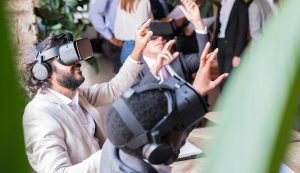There are many exciting new and emerging technologies making a splash these days and it can be easy to confuse them with one another. Virtual reality (VR) as well as augmented reality (AR), mixed reality (MR) and extended reality (XR) are four types of technology that you likely hear referenced, but how do they differ? Keep reading to find out.
VR

VR is a type of immersive experience that involves simulating reality using computers. Headsets are a vital component of VR, as you can use reality headsets to experience realistic images, sounds, and even sensations—all of which help replicate the feeling of being in a real environment or an imaginary world. While it isn’t always possible to do so, an authentic VR environment makes it possible to engage all five senses (sight, sound, smell, touch, and taste).
AR

AR takes a real-world environment and augments elements using computer-generated sensory input such as sound, video, graphics, or GPS data. The point of AR is to augment existing reality and to add to it in one way or another. Currently, smartphones and tablets are the most common way to access AR, but some custom glasses are also being used. Pokémon Go is a great example of AR. With that game, players use their phone to interact with the world around them, finding and catching Pokemon in their own backyards/their surroundings.
MR

MR, which can also be referred to as hybrid reality, merges a virtual world and the real world to create a new environment. In a MR environment both physical and digital objects can co-exist and interact together in real time. MR can place new imagery within a real space and can make it possible to interact with this imagery in our physical world.
XR

XR is one of the more recent technologies emerging in the immersive virtuality space. XR stands for extended reality and encompasses all forms of combined real and virtual environments. AR, MR, and VR are all included in XR. You can think of XR as an umbrella that brings those three terms together. The term XR is helping group all of this technology together and is making this space less confusing for consumers.
When XR Goes Global
When consumers interact with these virtual worlds (whether VR, AR, or MR is being utilized), language is often involved in one way or another. This is why it’s so important to localize the content featured in these worlds. That way, users worldwide can take advantage of the new developments and trends in immersive virtuality without being blocked by a language barrier. Localization also takes cultural differences into account, which can apply to all of the senses that these technologies can utilize to create a more immersive world.
After all, if the point of these technologies is to create truly immersive experiences, then localizing the world you’re creating for your target audience can help accomplish that goal.









